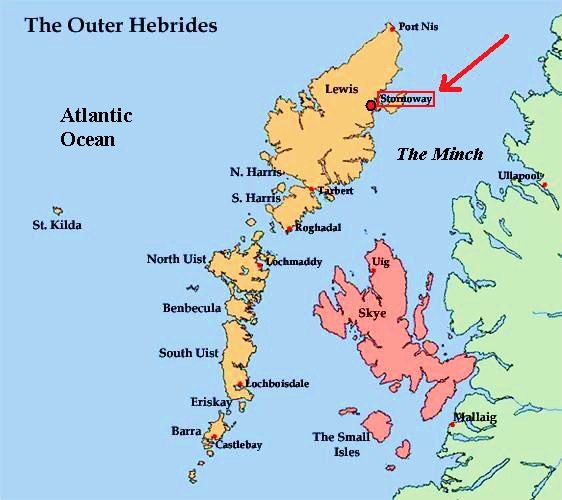Stornoway is a town on the Isle of Lewis, in the Outer Hebrides of Scotland, and one of the most remote scottish towns.
It's the largest town in the Scottish Western Isles, separated from the mainland by the Minch, a strait of the North Atlantic ocean, probably created by the fall of a meteorite. Stornoway is linked to the north-west of Scotland by a two-and-half hours trip by ferry.
Stornoway is an important port, and the major town and administrative centre of the Outer Hebrides.
Coordinates: 58° 12'N, 06° 23' W
Population: ~ 8 000 (urban area)
The frontline by the Minch's waters is also Stornoway's best historic heritage. The town has a distinctive Baltic profile.
The town was founded by Vikings in the early 9th century, under the name Stjórnavágr, Norse for "Steering Bay". It grew up around a sheltered natural harbour.
Stornoway grew as a fishing port through the 1700s; the 1800s saw the town take advantage of the herring boom, with as many as 6000 fishermen operating from the port during its peak.
Caledonian MacBrayde's ferry arriving in Stornoway
Today the harbour remains home to a significant fishing fleet, and busy with freight, ferry and leisure traffic.
Fresh seafood is always available at local markets and restaurants.
The waterfront town center, around the Townhall.
Francis street: the Townhall at right, then the 1838 St. Peter's church neo-gothic tower - also a town's landmark.
Perceval Square, the crossing of Cromwell and Point streets. the commercial area.
The historic center, known as "The Narrows", comprises the commercial streets, like Cromwell, Francis and Point Street.
Point Street
Kenneth Street
The Narrows are pedestrianised, providing easy foot access to a range of shops pleasantly different from the usual in other towns.
'Hebridean Jewelry', Cromwell street: a distinctive seafront building.
The pink façade with wallhead gable, in the corner of the main street, reminds dutch architecture - Stornoway had historical links with Holland during the herring boom.
Baltic bookshop, Cromwell street.
'Mosaic', Point Street, for gifts
'Influence', Francis Street, one of the best shops in town.
This'n'that, Point Street
'By Rosie' - travel goods.
'The Stag', bakery and tearoom
Downtown department store.
This precious late 19th century blue house is now a restaurant. Also reminiscent of the dutch building style, with a shaped wallhead gable, this "town house" was also built for a rich merchant.
'Digby Chick' restaurant.
Old McNeill's pub, c. 1825, on the corner of Cromwell and Francis street.
'An Lantair' art centre
An Lanntair is a multi-purpose arts centre comprising gallery, auditorium and cinema, bar and restaurant. Founded in 1985.
Lews Castle
The neo-gothic Lews Castle was built between 1847 and 1857 as a country house. From the early 1950s until 1989 the Castle served as a College - Lews Castle College.
Lews Castle is presently disused, its interior in decay, waiting for a development project - a hotel maybe, a museum hopefully.
Visitors are free to walk around the extensive grounds which feature over 100 species of trees.
The entrance gate to the castle grounds.
The Woodland Centre
A pavilion built in the Castle grounds, conceived as a large timber framed glass barn. The magnificently located Café has superb views to Stornoway Harbour.
Museum nan Eilean
One of its main exhibitions was the Lewis Chessmen, a famous early medieval set of chess pieces of scandinavian origin, dating from about 1150- 1200 AD. Some pieces are to go on permanent exhibition at Lewis Castle.
Lewis Chess pieces, scarved in Walrus ivory.
http://www.nms.ac.uk/explore/collections-stories/scottish-history-and-archaeology/lewis-chessmen/
I shall publish soon a new post here, on the subject of the Lewis Chessmen.
As for now, I close with images of Stornoway in dim light:
The skyline as viewed from the castle.
And at sunrise.
Reflections in the low sun.
One of the most precious northen towns.
























































